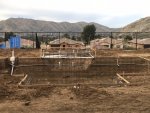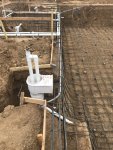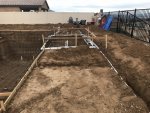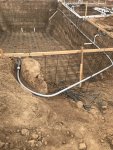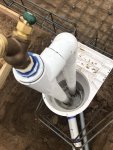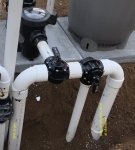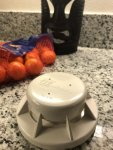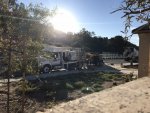Yah, your drain line is plumbed to your skimmer instead of running back to the pad. I can't for the life of me come up with a good reason for this, maybe others here can enlighten me. It saves the PB about $70 in parts plus some labor, I'd hate to think that's the only reason it was done.
So, in order to control the balance of suction between skimmer and main drain, you'll have to open the skimmer lid, take out the basket, get down on your hands and knees, or probably on your belly, stick your arm down into the skimmer and fool with some sort of diverter, under water, in order to adjust how much water gets sucked through the drain vs the skimmer. Sound like fun? All your other suction sources (spa drain and that third line (vacuum?), can be controlled independently, and quite easily, using those black three-way valves at your pad, above ground. That's like paying a lot of money to have a nice row of switches by your back door to turn all your yard lights on and off (porch light, bistro lights, pool lights), but the electrician wanted a little extra profit, so you'll have to walk across the yard, rain or shine, to fumble around in the bushes to plug in your garden lights!
In some pool setups, it's conceivable that one would set that diverter to balance skimmer and drain one time, and then never have to touch it again. So that might be worth saving $100. But in my pool, I'd have several reasons to adjust that balance, regularly:
- I like to do what I call "high speed skimmer runs." My pool surface collects leaves, bugs and various other types of floaties. They can be removed manually using a net, sure. But if I'm busy getting ready for a little pool party (usually in the kitchen) and want to "polish" the pool water nice and clean for my guests, I'll run just the skimmer, with the pump on high, to suck up all that stuff. It's a nice convenience when I need it. I'd want to close off all but the skimmer to maximize that function. I can do that with a push of a button on my living room wall.
- I don't care how much safer modern dual drains are over the old single-drain style that killed so many people, my granddaughter won't ever be in my pool with an active pool drain. I actually had my main drains removed for this reason, but if I still had the drains, I still might need to run the pump (for my solar heater), so I'd want a quick twist of the skimmer-drain valve to close off all but the skimmer: nice and safe!
- I might want to adjust the balance of drain-to-skimmer a few times a year. Maybe a little more skimmer in the fall to grab those extra leaves. Maybe a little more drain in the summer to help even out those warm/cold spots that seem to form in my pool when it's warm out.
- Or maybe I need to drain my pool below the skimmer opening, to get ready for a big rain storm or to exchange some old pool water with fresh, due to build up of salt or calcium. Quick twist of a knob to close the skimmer and I could use my pump to drain water, only from the drain, instead of having to buy and wrangle a sump pump, or start up a siphon hose.
- If you plan to add automation, now or in the future, above-ground three-way valves can be easily modified to accept motors that can automate the opening and closing of those valves. You may or may not ever need to automate the valve that controls your skimmer and drain, but you'd have the option (I would have a use for that). The in-skimmer diverter can't be automated.
Etc. Maybe you'll never want or need to do any of those things (or other things I haven't thought of). Maybe you will. The PB probably won't like it, but too bad, he should have done this right to begin with. If you have this corrected now, you might find it very useful, and convenient, later. Once the deck goes down, you'll never be able to.


